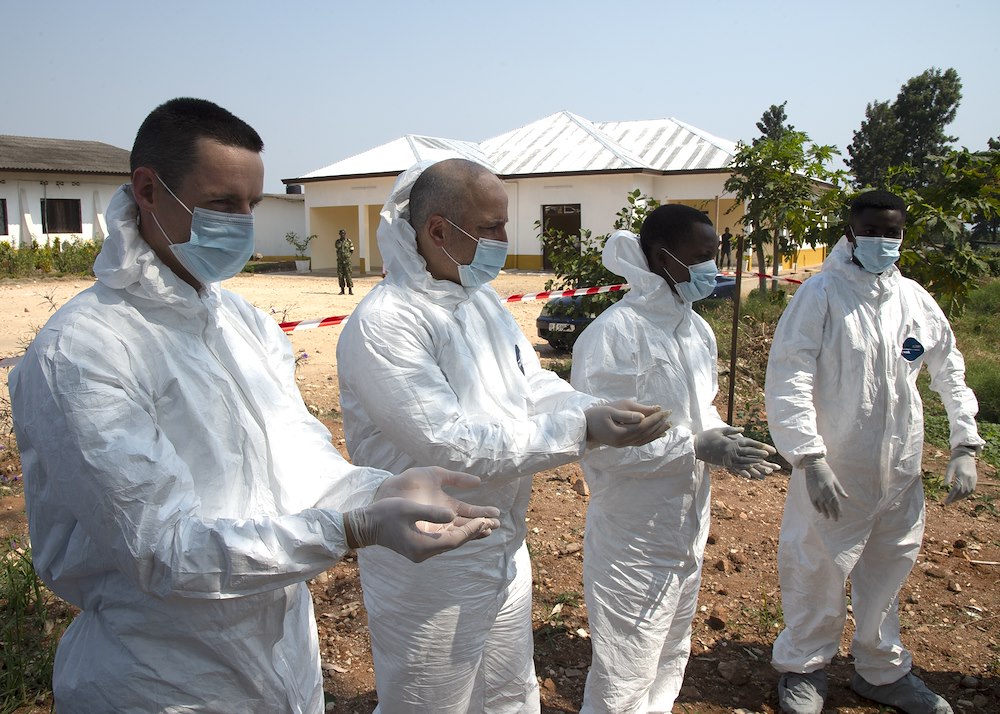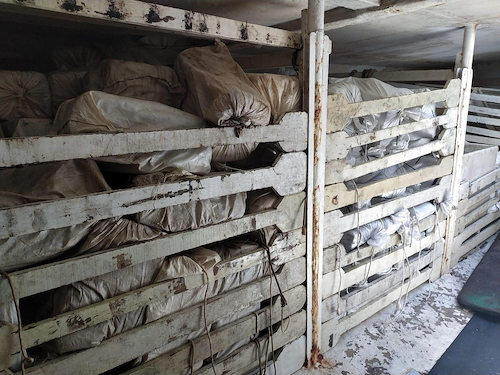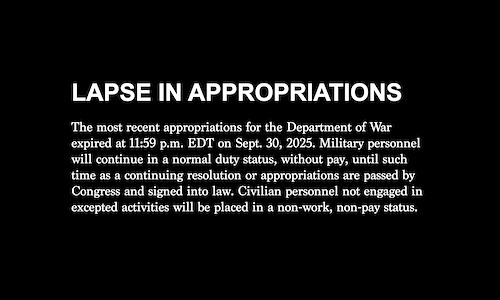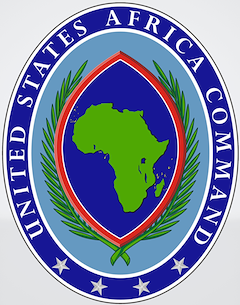
With the World Health Organization’s declaration on May 9, 2015, that Liberia was “Ebola free,” that nation and the international community supporting the counter-Ebola effort breathed a collective sigh of relief. And with the successful transition of support to civilian entities and decreasing military support requirements, the U.S. military team supporting Operation United Assistance (OUA) had begun the process to move assets no longer required for the operation to make them available for future missions.
Deliberate planning and actions across the entire logistics enterprise were essential to success in the early stages of OUA, just as they will be now as our logistics team ensures a smooth transition and a responsible retrograde of U.S. DoD capability from West Africa.
Operation United Assistance officially began on Sept. 16, 2014, when Maj. Gen. Darryl Williams, commanding general, U.S. Army Africa (USARAF), and his advance party arrived in Monrovia, Liberia, and established Joint Forces Command-Operation United Assistance (JFC-OUA). The JFC-OUA mission was to rapidly establish a field hospital for treatment of Ebola healthcare workers, and to establish diagnostic labs and Ebola treatment units. Those efforts were quickly followed by transitioning those capabilities and sustainment missions to the U.S. Agency for International Development (USAID) and other nongovernmental organizations (NGOs).
More on U.S. Africa Command Operation United Assistance response efforts:
In early January 2015, U.S. Africa Command (AFRICOM) Logistics Directorate authored an article focused on phases one through three of OUA, highlighting the work across the logistics enterprise in support of AFRICOM’s four major lines of effort:
- Command and control
- Logistics support
- Training
- Engineer support
Given the sheer magnitude of the contract-support leveraged, the directorate highlighted Operational Contract Support (OCS) as a key enabler for mission success. In context, the efforts across the logistics enterprise to set the theater for success and sustain those gains were executed well - from the initial deployment of USARAF, to the transition with the Joint Forces Command - 101st Airborne Division, and finally, through sustained regional coordination of U.S. military support to USAID and international relief efforts.
In late January, as lines of effort were nearly complete or completed, transitioning or transitioned; President Barack Obama approved the USAID and Department of Defense (DoD) plan to transition OUA to civilian and international response organizations, while retaining a small DoD element in Liberia for continued support, pending a national decision to terminate DoD involvement. This small, but capable, headquarters ensured uninterrupted support to USAID and oversaw the transition and authorized disposition of nearly $40 million worth of excess materiel thru the Foreign Excess Property process.
Considering all that has transpired since September 2014, there were a multitude of logistical lessons to be learned In the following section, we will delve deeper into three topical areas:
- Setting the theater
- Operational Contract Support
- Communication
 Lessons learned - setting the theater
Lessons learned - setting the theater
A hallmark of the logistics approach in OUA has been flexibility – sufficiently responsive to meet emerging requirements, but agile enough to de-scope when warranted. In fact, this flexibility was born of actions early in the operation; specifically, setting the theater and shaping the logistics operation to support execution.
With proactive support from strategic partners such as U.S. Transportation Command (USTRANSCOM), Army Materiel Command, and the Defense Logistics Agency (DLA), AFRICOM was able to rapidly deploy multiple joint task forces – port opening capabilities; multiple Joint Contingency Acquisition Support Office mission support teams and a director of mobility forces to the lead component and Joint Force Command; as well as multiple DLA distribution expeditionary teams across the joint operational area, and contracted expertise to gain swift momentum. This instant network of deployment/distribution nodes, warehousing capacity, operational contract oversight, and mobility staff expertise was critical to the reception, staging, onward movement and integration of the equipment, supplies, and people supporting OUA.
In all, this initial theater infrastructure and the forces that followed supported more than 350 strategic and 161 intra-theater airlift missions, that moving more than 6,000 passengers and more than 10,000 short tons of cargo. Additionally, the seaport teams handled multiple strategic sealift vessels deploying and redeploying close to 3,000 pieces from seaports in Liberia and Senegal.
Key engineering assessments, coordination, and repairs were critical to ensuring Roberts International Airfield, Liberia’s primary aerial port and lifeline, was able to support the increased flights for OUA. An Air Forces Africa (AFAF) pavements team provided an initial report on the airfield early during operations, allowing USTRANSCOM to make smart decisions on the weight of aircraft. Pavement experts from the Air Force Civil Engineer Center (AFCEC) and the United States Army Corps of Engineers (USACE) provided reach back expert analysis to help JFC OUA engineers develop a simple maintenance and minor repair strategy using Logistics Civil Augmentation Program and local contractors to keep the airfield open. Ultimately an AFCEC pavements team performed a detailed inspection of the airfield. The report concluded OUA operations had not materially worsened the airfield but did make recommendations to a long term repair project which may lead to a USAID funded project.
It was evident early that a blended engineer approach was needed to obtain materials and build 10 ETUs to aid Liberia’s recovery. Building materials were obtained via local, U.S., and European sources through existing DoD stocks and multiple sourcing strategies, including DLA, 414th Contract Support Brigade, and LOGCAP. Manpower and equipment capacity issues were a concern because the ETUs needed to be constructed simultaneously, leading to a multi-pronged execution strategy. In the end, six ETUs were built through LOGCAP, three by Armed Forces Liberia, and one by the 902nd Engineering Platoon.
 On the medical operations and medical logistics side, there were also significant efforts towards setting the theater. Most notably, coordination for the delivery and set-up of the Monrovia Medical Unit - a 25-bed emergency medical facility, eventually staffed by the U.S. Public Health Service and dedicated to treatment of ETU healthcare workers. Additionally, detailed collaboration and coordination efforts with USAID, the Center for Disease Control, the Defense Threat Reduction Agency and the DLA were needed to define, procure, and deliver essential personal protective equipment to support the lead federal agency’s requirements.
On the medical operations and medical logistics side, there were also significant efforts towards setting the theater. Most notably, coordination for the delivery and set-up of the Monrovia Medical Unit - a 25-bed emergency medical facility, eventually staffed by the U.S. Public Health Service and dedicated to treatment of ETU healthcare workers. Additionally, detailed collaboration and coordination efforts with USAID, the Center for Disease Control, the Defense Threat Reduction Agency and the DLA were needed to define, procure, and deliver essential personal protective equipment to support the lead federal agency’s requirements.
Setting the theater quickly and comprehensively paid dividends, but it wasn’t without friction. Our experience in OUA highlighted the importance of pre-coordinated solutions to fill capability gaps. More specifically, sharing forces - when necessary – with fellow combatant commands provided us the necessary capability, but the lack of assigned or allocated (dedicated) capabilities and resulting delays did impact some mission execution. This is not a new problem for AFRICOM. The persistent lack of logistics enablers remains a challenge, but multiple efforts to mitigate the shortfall thru Global Force Management and codified force sharing agreements, continue.
“Operationalizing” contract support
The plan from the onset of OUA was to attempt to contract as much of the effort as possible to minimize the military footprint, yet still meet all USAID support requirements.
Through the OUA experience, an Operational Contract Support Integration Cell was established as outlined in the recently revised joint publication on OCS. AFRICOM assigned USARAF as the lead service for contracting to synchronize, coordinate, and contract for common contract support requirements in the joint operating area. This central entity coordinated efforts and executed functions as a single point-of-entry for processing contracted requirements and OCS-related information that enabled timely and relevant contracting solutions for the joint force command.
By the end of OUA there were more than 400 contracts, totaling more than $120 million, employed.
USTRANSCOM played a major role by lending their Transportation Intelligence Center (TIC) to vet more than 30 contractors and ensure contracts were not going to bad actors.
Communication
As stakeholders across the Joint Logistics Enterprise experienced, synchronizing the efforts of the enterprise was a significant undertaking. We were challenged by limited communication infrastructure in the joint operations area and coordination across multiple time zones, but our daily logistics synchronization session facilitated cross-talk and coordination – regularly bringing together over 100 stakeholders for a one hour or less, virtual session via Defense Connect Online. Every 24 hours, the command's joint logistics operations center would facilitate a verbal update giving senior logistics leaders the opportunity to provide guidance and perspective and all stakeholders the chance to update the assembled group.
While not a perfect process, the virtual logistics synchronization remained a rallying point thru the critical phases of OUA. Going forward, the command has institutionalized this model for coordination and synchronization of support to operations.
Conclusion
Logistics is all about aligning the rights—getting the right stuff to the right place at the right time. With the help of an incredible logistics team, demonstrating great agility and collective responsiveness, the command was able to get a lot right during OUA. That is not to say there weren't challenges along the way. In the end, the J4 Directorate logged 41 official lessons learned in the Joint Lessons Learned System.
We believe OUA serves as a positive example of how DoD can support a lead federal agency such as USAID, fulfill some truly requirements, and then transition our efforts to other priorities as circumstances on the ground allow, while maintaining the progress we’ve made together via our long term relationship with the partner nation. Our hope is that the lessons learned and best practices highlighted here will benefit the Joint Logistics Enterprise as well as fellow combatant and service component commands while responding to future foreign humanitarian assistance requirements.


 Lessons learned - setting the theater
Lessons learned - setting the theater On the medical operations and medical logistics side, there were also significant efforts towards setting the theater. Most notably, coordination for the delivery and set-up of the Monrovia Medical Unit - a 25-bed emergency medical facility, eventually staffed by the U.S. Public Health Service and dedicated to treatment of ETU healthcare workers. Additionally, detailed collaboration and coordination efforts with USAID, the Center for Disease Control, the Defense Threat Reduction Agency and the DLA were needed to define, procure, and deliver essential personal protective equipment to support the lead federal agency’s requirements.
On the medical operations and medical logistics side, there were also significant efforts towards setting the theater. Most notably, coordination for the delivery and set-up of the Monrovia Medical Unit - a 25-bed emergency medical facility, eventually staffed by the U.S. Public Health Service and dedicated to treatment of ETU healthcare workers. Additionally, detailed collaboration and coordination efforts with USAID, the Center for Disease Control, the Defense Threat Reduction Agency and the DLA were needed to define, procure, and deliver essential personal protective equipment to support the lead federal agency’s requirements.


